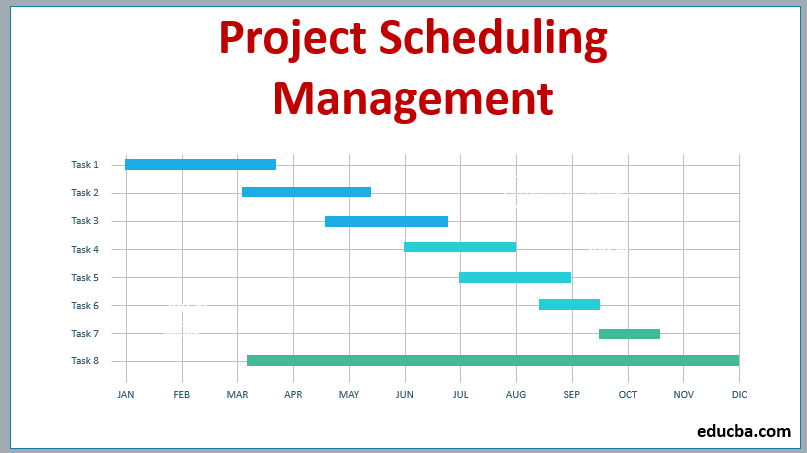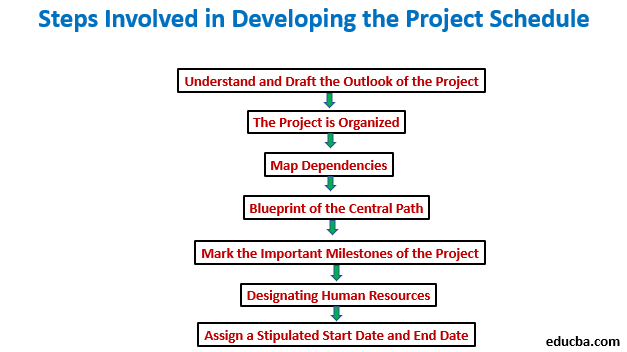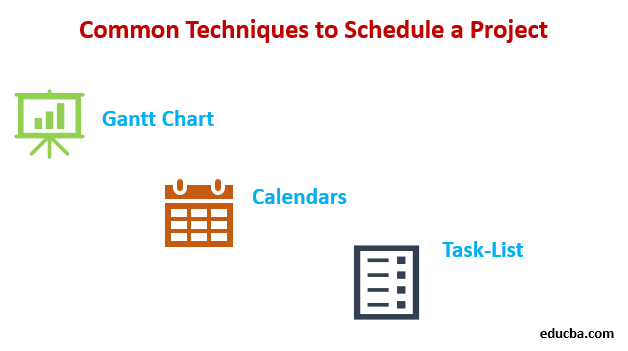Introduction to Project Scheduling Management
Project scheduling management, commonly used in project management, is defined as scheduling an entire project, including the minute components, from the start date to the finish date. This methodology incorporates scheduling the list of a project’s activities, milestones, and deliverables. It is a systematic projection of the timeline composed from the day the project is conceptualized to the day the project is completed and everything in between.
A project schedule can be created only if there is a clear vision for the project. A schedule can be scripted when a project can be integrated into the various little deliverables’ intricate functional structure.
What is the Aim of a Project Schedule?
The objective of any project schedule is to guide the employees in completing the project systematically and organized through efficient planning that optimizes the time available. The schedule ensures the employees adhere to a proposed timeline, minimizing delays.
Scheduling the project is part of any project planning. An explicit project schedule aids in directing the employees through a project’s life-cycle, thereby ensuring the employees do not get deviated or hasty.
Short Description of Project Planning
A project contains five major components, wherein the project schedule is an essential part of the second component.
- The Idea: This first component conceptualizes the project and discerns how smoothly it can be completed with the given resources.
- Framing the Blueprint of the Project: This component defines and properly plans out the whole project. Project planning includes listing and calculating out the budget, developing schedules, and listing the resources required.
- The Launch of the Project: The project is executed at this step; that is, the employees begin working on the assigned tasks.
- The Project Performance: This is the phase where the project’s progression is compared to the expectations that were laid out.
- The Closure: This simple component seals the project’s delivery, post which many organizations tend to evaluate the project’s successes and failures to improve on forthcoming projects.
What are the Steps Involved in Developing the Project Schedule?
1. Understand and Draft the Outlook of the Project
As mentioned previously, the project must have a scope to create a project schedule. This involves the project’s expectations, proposed results, and the requisites required to complete the project. Also, the scope outlines the required resources as well as the cost-and-time constraints. Hence, this step is carried out with the stakeholders. Simultaneously, it is important to draft the project into a functional structure highlighting all the important tasks and deliverables. (Note: The breakdown structure lists the tasks, excluding the dates).
2. The Project is Organized
Once the outlook and the working structure, with the integrated components, are sketched, it is possible to enlist all the project assignments. After spelling out every task, it is essential to organize them on a priority basis, along with the estimated time taken to execute each task. It is equally inherent to map out the required resources.
3. Map Dependencies
This goes hand-in-hand with organizing the project’s activities. This step provides clarity in the relationship between each activity. Thus, it is simple to identify the activity that precedes an activity and the activity superseding an activity. The dependency can be classified as:
- Finish-to-start: where it is vital to finish one assignment before proceeding to the next
- Start-to-start: where it is essential to start a task before beginning another
- Finish-to-finish: where it is important to finish a task before completing another
- Start-to-finish: where it is essential to start a task before ending another
4. Blueprint of the Central Path
Completing a task on time becomes imperative when the time interval between its due date and the succeeding activity’s start date is zero. In short, delaying that activity will delay the whole project. Thus, a series of vital tasks are charted out to avoid an overall delay. This outline can define the time span for project completion.
5. Mark the Important Milestones of the Project
Milestones aid in tracking the project at defined intervals. This helps the employees to adhere to the course of the project. From an eagle’s perspective, it shows if the project is well within the defined time.
These checkpoints are of two types – external and internal. The external milestones are meant for the sponsors, stakeholders, clients, etc.; it reveals where the project has reached. The internal milestones are set for the employees directly working on the project; it guides the employees in tracing the project’s progression.
6. Designating Human Resources
The project schedule remains incomplete without the allocation of duties to employees. The thumb rule allocates 3/4th of their time for the primary task and the remaining quarter to any secondary duties like assisting or administrative duties.
7. Assign a Stipulated Start Date and End Date
Upon understanding the duration required for each task, setting the milestones, and estimating the total time required to complete the project, the start and end dates can be indicated. The expected start date is set based on skilled human resources. The projected end date may change due to employees’ leaves, government holidays, and other unexpected factors.
What are the Common Techniques to Schedule a Project?
There are a few popular methods that most PMOs opt for when developing a project schedule, namely, Task-List, Gantt Chart, Calendars, Integrated Time Sheets, etc. Most websites provide free online software like “2-plan” with an interactive Gantt Chart to help manage various scheduling components like employee availability, timesheets, or task allocations.
Here is a brief idea of:
Task-List
This method documents a list of tasks for each employee in the project, either in a word processor or a spreadsheet. This simple method is ideal for any small project. A few, like Zoho, can be collaborated with websites, like Google+, to aid the employees in updating project status directly in the document. However, the drawback is that a manual update is constantly required to track the project’s progress.
Gantt Chart
Gantt Chart is a bar chart of the activity sequence against time. Each bar signifies a task with its start and end date, representing the duration taken for completion. It also indicates an overlap of activities, dependencies between the tasks, and the project’s start and due date. Most PMOs highly favored this tool due to the visualization that helps to track the project better. The Gantt Chart is an efficient tool to report status updates and estimate the time required to complete the project.
Calendars
Calendars can be duplicated into many files with a unique name for each. Thus, enabling the possibility to create a calendar for every project registering every task. This way, a timeline for the entire project is available. Calendars can be shared with employees. The drawbacks to calendars are the inability to assign a task to each employee and the lack of representation of task dependencies.
How is a Project Schedule Assessed?
A project schedule is of absolute quality if –
- It is updated daily or weekly.
- The estimation value at completion matches the baseline value.
- If the work is distributed evenly among employees, ensuring a smooth completion
A project schedule is extremely useful for a software company, construction company, event management organization, school events, etc. Most people have adopted this technique in their daily lives. This is an organizational method developed to make life convenient because it ensures how efficiently time is utilized. In short, it’s making the most with the little in hand.
Recommended Articles
This is a guide to Project Scheduling Management. Here we discuss the steps and common techniques to schedule a Project. You may also look at the following articles to learn more –




